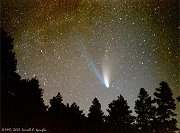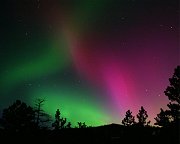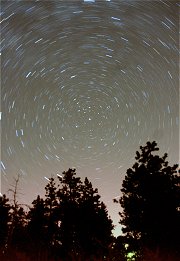Rocky Mountain
National Park - Complete Information Resource
Stargazing:
 One
activity in Rocky Mountain National Park that is
not as well publicized as the others is stargazing. Due to
it's somewhat remote location and easy access to high
altitudes, Rock Mountain National Park boasts some
of the darkest, most transparent skies in the continental
United States. One
activity in Rocky Mountain National Park that is
not as well publicized as the others is stargazing. Due to
it's somewhat remote location and easy access to high
altitudes, Rock Mountain National Park boasts some
of the darkest, most transparent skies in the continental
United States.
 Many
superb photographs of comets, planetary conjunctions and
stunning shots of the night skies have come for Rocky
Mountain National Park. The best viewing is on cold
winter evenings when the stars are spellbinding in their
number and brightness. Summer nights also provided many
great opportunities for stargazing, including the comfort
of the warm summer nights during viewing of some major
meteor showers. Many
superb photographs of comets, planetary conjunctions and
stunning shots of the night skies have come for Rocky
Mountain National Park. The best viewing is on cold
winter evenings when the stars are spellbinding in their
number and brightness. Summer nights also provided many
great opportunities for stargazing, including the comfort
of the warm summer nights during viewing of some major
meteor showers.
 Photographing
the night sky is best accomplished using a SLR camera
(film or digital). Wide angle lenses work well for
constellations and meteor showers with standard 50mm
lenses best for comets. Films ISO speeds of 400 to 3200
are recommended with a wide aperture (f/1.2 - f/5.6) and exposures a minimum of 30 seconds. It
should be noted that exposures longer that 30 seconds will
result in a trailing behind the stars. This is due to a
tracking error as a result of the Earth's rotation. The
photo to the right shows this rotation well. The camera
was centered on the "North Star", Polaris. This
is Earth's northern celestial pole and the center of the
rotation, as viewed from the northern hemisphere of our
planet. Photographing
the night sky is best accomplished using a SLR camera
(film or digital). Wide angle lenses work well for
constellations and meteor showers with standard 50mm
lenses best for comets. Films ISO speeds of 400 to 3200
are recommended with a wide aperture (f/1.2 - f/5.6) and exposures a minimum of 30 seconds. It
should be noted that exposures longer that 30 seconds will
result in a trailing behind the stars. This is due to a
tracking error as a result of the Earth's rotation. The
photo to the right shows this rotation well. The camera
was centered on the "North Star", Polaris. This
is Earth's northern celestial pole and the center of the
rotation, as viewed from the northern hemisphere of our
planet.
Bookmark This Page
|